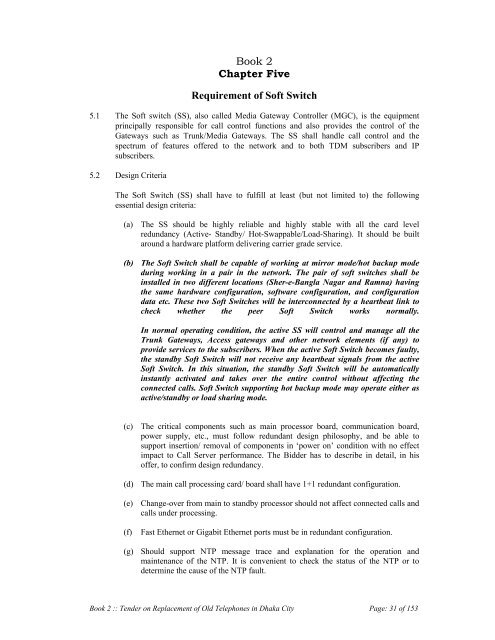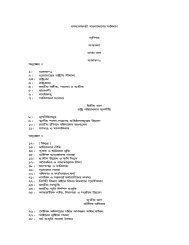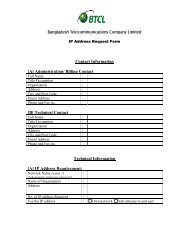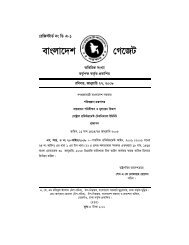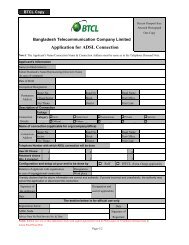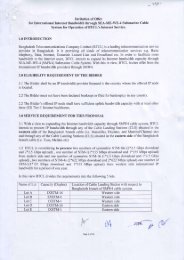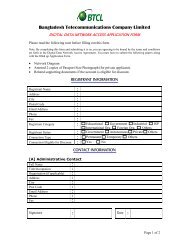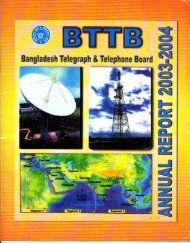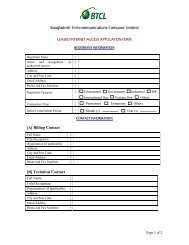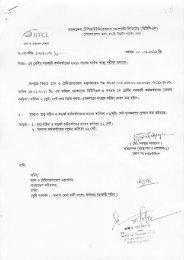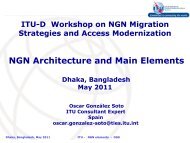BANGLADESH TELECOMMUNICATIONS COMPANY LIMITED - BTCl
BANGLADESH TELECOMMUNICATIONS COMPANY LIMITED - BTCl
BANGLADESH TELECOMMUNICATIONS COMPANY LIMITED - BTCl
You also want an ePaper? Increase the reach of your titles
YUMPU automatically turns print PDFs into web optimized ePapers that Google loves.
Book 2Chapter FiveRequirement of Soft Switch5.1 The Soft switch (SS), also called Media Gateway Controller (MGC), is the equipmentprincipally responsible for call control functions and also provides the control of theGateways such as Trunk/Media Gateways. The SS shall handle call control and thespectrum of features offered to the network and to both TDM subscribers and IPsubscribers.5.2 Design CriteriaThe Soft Switch (SS) shall have to fulfill at least (but not limited to) the followingessential design criteria:(a) The SS should be highly reliable and highly stable with all the card levelredundancy (Active- Standby/ Hot-Swappable/Load-Sharing). It should be builtaround a hardware platform delivering carrier grade service.(b) The Soft Switch shall be capable of working at mirror mode/hot backup modeduring working in a pair in the network. The pair of soft switches shall beinstalled in two different locations (Sher-e-Bangla Nagar and Ramna) havingthe same hardware configuration, software configuration, and configurationdata etc. These two Soft Switches will be interconnected by a heartbeat link tocheck whether the peer Soft Switch works normally.In normal operating condition, the active SS will control and manage all theTrunk Gateways, Access gateways and other network elements (if any) toprovide services to the subscribers. When the active Soft Switch becomes faulty,the standby Soft Switch will not receive any heartbeat signals from the activeSoft Switch. In this situation, the standby Soft Switch will be automaticallyinstantly activated and takes over the entire control without affecting theconnected calls. Soft Switch supporting hot backup mode may operate either asactive/standby or load sharing mode.(c) The critical components such as main processor board, communication board,power supply, etc., must follow redundant design philosophy, and be able tosupport insertion/ removal of components in ‘power on’ condition with no effectimpact to Call Server performance. The Bidder has to describe in detail, in hisoffer, to confirm design redundancy.(d) The main call processing card/ board shall have 1+1 redundant configuration.(e) Change-over from main to standby processor should not affect connected calls andcalls under processing.(f)Fast Ethernet or Gigabit Ethernet ports must be in redundant configuration.(g) Should support NTP message trace and explanation for the operation andmaintenance of the NTP. It is convenient to check the status of the NTP or todetermine the cause of the NTP fault.Book 2 :: Tender on Replacement of Old Telephones in Dhaka City Page: 31 of 153


